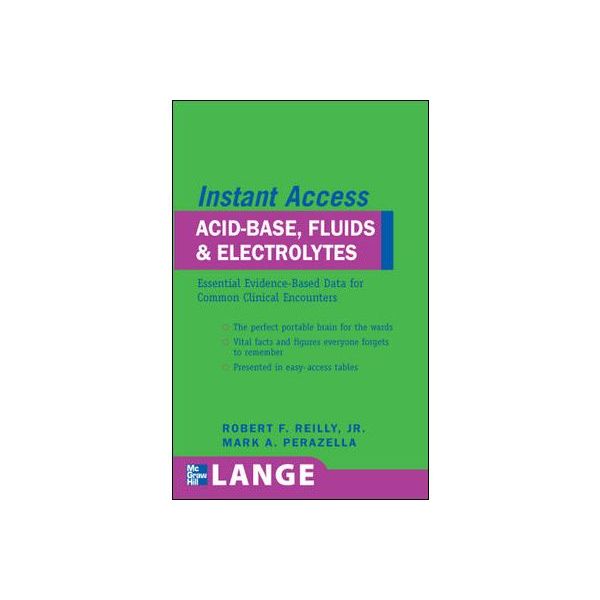LANGE INSTANT ACCESS: ACID-BASE, FLUIDS,
Essential Evidence-Based Data for Common Clinical Encounters
"This is very useful for providers who desire a fast review of fluid, electrolyte, and acid-base disorders without asking for in-depth information. Background information about pathophysiology and references are not included, but are not needed. This makes the book unique and quite different from other available resources on the topic. 3 Stars."--Doody's Review Service
Make sense of acid-base and electrolytes with this compact, on-the-go guide--filled with clinical facts, figures, and data.
In this ultra-convenient resource, the authors have distilled down the most relevant insights from their acclaimed text Nephrology in 30 Days, giving you a complete, yet concise overview of acid-based and electrolytes--supported by evidence-based findings.
You'll find at-a-glance tables and a bulleted format that puts key diagnostic and clinical information right at your fingertips. This one-stop guide gets you up to speed on the major issues in acid-base and electrolyte disturbances, from metabolic acidosis to serum calcium disorders. It's the perfect clinical companion to more in-depth acid-base texts--one that goes beyond educational principles to focus on the real world of clinical medicine and patient management.
- The perfect portable brain for the wards
- Vital facts and figures everyone forgets to remember
- Presented in easy-access tables
| Author | REILLY |
|---|---|
| Table Of Content | Chapter 1: Body Fluid Compartments and Intravenous Fluid Replacement, Robert F. Reilly, Jr., and Mark A. Perazella1. Body fluid compartments2. Intravenous solutions 3. General principles 4. Assessing extracellular fluid volume 5. Fluid resuscitation 6. Clinical examples of fluid resuscitation Chapter 2: Disorders of Sodium Balance (Edema, Hypertension or Hypotension), Robert F. Reilly, Jr., and Mark A. Perazella1. Introduction2. Regulation of Na+ transport in kidney 3. Disorders associated with increased total body Na+ (ECF volume expansion) 4. Clinical manifestations of increased total body Na+ (ECF volume expansion) 5. General approach to the edematous patient 6. General treatment of the edematous patient 7. Clinical manifestations of decreased total body Na+ (ECF volume depletion) 8. General approach to the volume depleted patient 9. General Treatment of the Volume Depleted Patient Chapter 3: Disorders of Water Balance (Hypo- and Hypernatremia), Robert F. Reilly, Jr., and Mark A. Perazella1. Introduction2. Hyponatremia 3. Etiology of hyponatremia 4. Signs and symptoms 5. Diagnosis 6. Treatment 7. Hypernatremia 8. Etiology 9. Signs and symptoms 10. Diagnosis 11. Treatment Chapter 4: Diuretics, Mark A. Perazella1. Introduction2. Sites of diuretic action in kidney 3. Diuretic resistance 4. Clinical conditions associated with diuretic resistance 5. Treatment of diuretic resistance Chapter 5: Disorders of K+ balance (Hypo- and Hyperkalemia), Mark A. Perazella1. Introduction2. K+ homeostasis 3. Role of K+ in the resting membrane potential 4. Cellular K+ distribution 5. K+ handling by the kidney 6. Factors controlling renal K+ excretion 7. Hypokalemia8. Etiology 9. Increased cellular K+ uptake 10. Increased renal K+ losses 11. Approach to the patient 12. Clinical manifestations 13. Treatment 14. Hyperkalemia 15. Etiology 16. Approach to the patient 17. Clinical manifestations 18. Treatment Chapter 6: Metabolic Acidosis, Dinkar Kaw and Joseph I. Shapiro1. Acid-Base Chemistry and Biology2. The Bicarbonate Buffering System 3. Acid Excretion by the Kidney 4. Clinical Approach to the Patient with an Acid-Base Disorder 5. Pathophysiology, Compensation and Consequences 6. Use of the Serum and Urine Anion Gap in the Differential Diagnosis of Metabolic Acidosis 7. Differential Diagnosis of Metabolic Acidosis 8. Causes of Metabolic Acidosis 9. Treatment of Metabolic Acidosis Chapter 7: Metabolic Alkalosis, Dinkar Kaw and Joseph I. Shapiro1. Introduction2. Maintenance of Metabolic Alkalosis 3. Clinical Features 4. Differential Diagnosis 5. Cl--Responsive and Cl--Resistant Causes of Metabolic Alkalosis 6. Treatment Chapter 8: Respiratory and Mixed Acid-base Disturbances, Youngsook Yoon and Joseph I. Shapiro1. Respiratory Disturbances2. Respiratory Acidosis 3. Respiratory Alkalosis 4. Mixed Disturbances Chapter 9: Disorders of Serum Calcium, Robert F. Reilly, Jr.1. Regulation2. Hypercalcemia 3. Hypocalcemia Chapter 10: Disorders of Serum Phosphorus, Robert F. Reilly, Jr.1. Regulation2. Hyperphosphatemia 3. Hypophosphatemia Chapter 11: Disorders of Serum Magnesium, Robert F. Reilly, Jr.1. Introduction2. Hypomagnesemia 3. Hypermagnesemia Chapter 12: Appendix, Mark A. Perazella and Robert F. Reilly, Jr.1. Introduction2. Clinical assessment of glomerular filtration rate (GFR) |
| Publish Date | 15 Jun 2007 |




